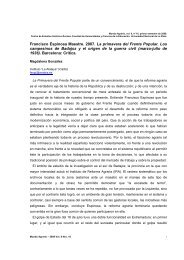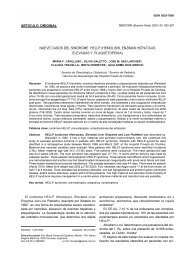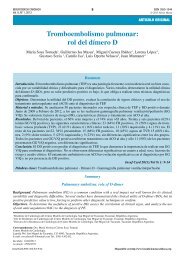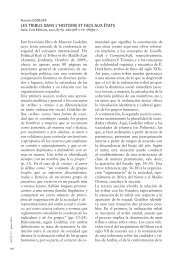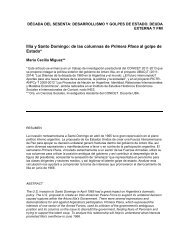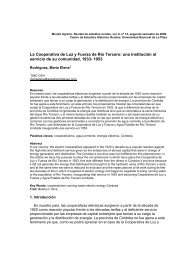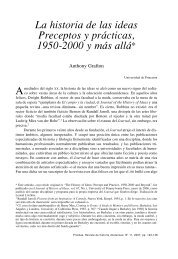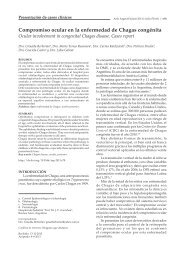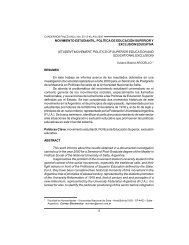Placentation patterns and seed number in fruits of - SciELO
Placentation patterns and seed number in fruits of - SciELO
Placentation patterns and seed number in fruits of - SciELO
Create successful ePaper yourself
Turn your PDF publications into a flip-book with our unique Google optimized e-Paper software.
DARWINIANA 45(2): 163-174. 2007 ISSN 0011-6793<br />
PLACENTATION PATTERNS AND SEED NUMBER IN FRUITS OF SOUTH AMERICAN<br />
SOLANUM SUBGEN. LEPTOSTEMONUM (SOLANACEAE) SPECIES<br />
Franco E. Chiar<strong>in</strong>i & Gloria E. Barboza<br />
Instituto Multidiscipl<strong>in</strong>ario de Biología Vegetal (CONICET-UNC), casilla de correo 495, 5000 Córdoba, Argent<strong>in</strong>a;<br />
chiar<strong>in</strong>i@imbiv.unc.edu.ar (author for correspondence).<br />
Abstract. Chiar<strong>in</strong>i, F. E. & G. E. Barboza. 2007. <strong>Placentation</strong> <strong>patterns</strong> <strong>and</strong> <strong>seed</strong> <strong>number</strong> <strong>in</strong> <strong>fruits</strong> <strong>of</strong> South American<br />
Solanum subgen. Leptostemonum (Solanaceae) species. Darw<strong>in</strong>iana 45(2): 163-174.<br />
Thirty-seven South American species represent<strong>in</strong>g seven sections <strong>of</strong> Solanum subgen. Leptostemonum<br />
were analyzed. Andromonoecious as well as hermaphrodite species were considered. The<br />
length <strong>and</strong> width <strong>of</strong> their <strong>fruits</strong> was measured, <strong>and</strong> the <strong>number</strong> <strong>of</strong> <strong>seed</strong>s per fruit was counted. Medial<br />
cross sections <strong>of</strong> fresh, ripe <strong>fruits</strong> were observed with a stereoscopic microscope <strong>and</strong> illustrated. Six<br />
placentation <strong>patterns</strong> <strong>and</strong> three types <strong>of</strong> <strong>seed</strong>s were described. A relationship among <strong>seed</strong> <strong>number</strong>, fruit<br />
size, fruit color <strong>and</strong> sexual system was detected by means <strong>of</strong> statistical analysis. These results suggest<br />
that <strong>and</strong>romonoecy affects fruit size <strong>and</strong> placentation <strong>patterns</strong>, <strong>in</strong> order to conta<strong>in</strong> a higher <strong>number</strong> <strong>of</strong><br />
<strong>seed</strong>s per fruit.<br />
Keywords. Andromonoecy, Leptostemonum, placentation, <strong>seed</strong> <strong>number</strong>, Solanum, South America.<br />
Resumen. Chiar<strong>in</strong>i, F. E. & G. E. Barboza. 2007. Patrones de placentación y número de semillas en frutos de especies<br />
sudamericanas de Solanum subgen. Leptostemonum (Solanaceae). Darw<strong>in</strong>iana 45(2): 163-174.<br />
Se analizaron 37 especies sudamericanas pertenecientes a siete secciones de Solanum subgen. Leptostemonum.<br />
Fueron consideradas tanto especies <strong>and</strong>romonoicas como hermafroditas. Se midió el<br />
ancho y el largo de sus frutos y se contó el número de semillas por fruto. Se estudiaron bajo lupa y se<br />
ilustraron cortes por la zona media de frutos frescos maduros. Se describieron seis patrones de placentación<br />
y tres tipos de semillas. Mediante análisis estadístico, se detectó una relación entre el<br />
número de semillas, el tamaño del fruto, el color del fruto y el sistema sexual. Estos resultados sugieren<br />
que la <strong>and</strong>romonoecia afecta al tamaño del fruto y su patrón de placentación, para contener un<br />
mayor número de semillas.<br />
Palabras clave. Andromonoecia, Leptostemonum, número de semillas, placentación, Solanum, Sudamérica.<br />
INTRODUCTION<br />
Solanum L. is one <strong>of</strong> the largest genera among<br />
Angiosperms, <strong>in</strong>clud<strong>in</strong>g about 1100-1400 species<br />
(Nee, 1999; Hunziker, 2001; Bohs, 2005) that<br />
grow <strong>in</strong> all k<strong>in</strong>ds <strong>of</strong> habitats. The largest subgenus<br />
with<strong>in</strong> Solanum is Leptostemonum (Dunal) Bitter,<br />
with ca. 450 species (Nee, 1999). This subgenus,<br />
with n<strong>in</strong>e sections <strong>in</strong> South America, <strong>in</strong>cludes edible<br />
species <strong>of</strong> economic importance (S. melongena<br />
L., “Eggplant”; S. sessiliflorum Dunal, “Cocona”<br />
or “Cubiu”; S. quitoense Lam., “Naranjilla” or<br />
“Lulo”), <strong>and</strong> also weeds (S. viarum Dunal, “Tropical<br />
soda apple”; S. elaeagnifolium Cav., “Silverleaf<br />
nightshade”; S. sisymbriifolium Lam., “Sticky<br />
nightshade” or “Wild tomato”; S. rostratum Dunal,<br />
“Buffalo bur”, “Bull thistle” or “Texas thistle”).<br />
Several species <strong>of</strong> Solanum subgen. Leptostemonum<br />
have been studied due to their <strong>and</strong>romonoecy<br />
or functional dioecy (Wakhloo, 1975a, b;<br />
Anderson, 1979; Dulberger et al., 1981; Coleman<br />
& Coleman, 1982; Solomon, 1987; Anderson &<br />
Symon, 1989; Diggle, 1991, 1993). The <strong>and</strong>romonoecy<br />
has been l<strong>in</strong>ked with fruit type, <strong>and</strong> a corre-<br />
Orig<strong>in</strong>al recibido el 10 de agosto de 2007; aceptado el 2 de noviembre de 2007<br />
163
DARWINIANA 45(2) 163-174. 2007<br />
lation between fruit size <strong>and</strong> the degree <strong>of</strong><br />
<strong>and</strong>romonoecy has been proposed for some<br />
species (Whalen & Costich, 1986). Recently, <strong>in</strong> a<br />
study that embraced five species <strong>of</strong> Solanum sect.<br />
Acanthophora <strong>and</strong> eight <strong>of</strong> sect. Lasiocarpa, Miller<br />
& Diggle (2007) demonstrated that fruit size is<br />
positively correlated with the proportion <strong>of</strong> stam<strong>in</strong>ate<br />
flowers produced with<strong>in</strong> <strong>in</strong>florescences.<br />
These authors concluded that <strong>and</strong>romonoecy is a<br />
mechanism to regulate allocation to female function<br />
(i.e., fruit production) <strong>in</strong>dependently <strong>of</strong> allocation<br />
to male function.<br />
Despite these suggestive previous works,<br />
detailed studies on fruit structure <strong>of</strong> subgenus Leptostemonum<br />
are rare. Only some scattered species<br />
have been studied (Miller, 1969; Dave et al., 1979;<br />
Dottori & Cosa, 1999, 2003), but a comprehensive<br />
analysis <strong>of</strong> the subgenus as a natural group is lack<strong>in</strong>g.<br />
With regard to the placentation <strong>patterns</strong>, only<br />
general surveys for Solanaceae (Nee, 1986), <strong>and</strong><br />
for the genus Solanum (Symon, 1987) are available.<br />
This is unfortunate, s<strong>in</strong>ce the contributions <strong>of</strong><br />
morphology <strong>and</strong> anatomy to systematics are widely<br />
known, so a study consider<strong>in</strong>g any fruit structure<br />
would be valuable for Solanum subgen. Leptostemonum.<br />
The present work attempts to provide<br />
morpho-anatomical <strong>in</strong>formation <strong>in</strong> order for it<br />
to be used systematically, <strong>and</strong> as a contribution to<br />
underst<strong>and</strong> the relationship between function <strong>and</strong><br />
structure <strong>in</strong> South American species <strong>of</strong> Solanum<br />
subgen. Leptostemonum. Our proposal is that placentation<br />
<strong>and</strong> <strong>seed</strong> <strong>number</strong> are <strong>in</strong>fluenced by the<br />
sexual system.<br />
MATERIALS AND METHODS<br />
We analyzed as many species as possible, try<strong>in</strong>g<br />
to study at least one species <strong>of</strong> each section.<br />
Thirty seven wild species represent<strong>in</strong>g seven sections<br />
<strong>of</strong> Solanum subgenus Leptostemonum were<br />
sampled (see appendix 1).<br />
Several phylogenetic approaches have be<strong>in</strong>g<br />
carried out by different authors (Bohs, 2005; Lev<strong>in</strong><br />
et al., 2005, 2006) <strong>in</strong> which <strong>in</strong>formal <strong>in</strong>frageneric<br />
group<strong>in</strong>g (clades) have been def<strong>in</strong>ed with<strong>in</strong><br />
Solanum, <strong>and</strong> probably will be given a formal status<br />
(Nee et al., 2006). Meanwhile, we have<br />
arranged the species accord<strong>in</strong>g to the last conventional<br />
taxonomic treatment (Nee, 1999) (Table 1).<br />
Samples <strong>of</strong> at least 10 <strong>fruits</strong> per species (<strong>of</strong> different<br />
<strong>in</strong>dividuals, when possible) were taken. The<br />
length <strong>and</strong> width <strong>of</strong> each fruit were measured with<br />
a Vernier calliper, <strong>and</strong> the <strong>number</strong> <strong>of</strong> <strong>seed</strong>s was<br />
counted. Averages <strong>of</strong> these measurements are<br />
detailed <strong>in</strong> Table 1. Medial cross sections <strong>of</strong> fresh,<br />
ripe <strong>fruits</strong> were observed <strong>in</strong> stereoscopic microscope<br />
preparations. <strong>Placentation</strong> <strong>patterns</strong> are based<br />
on these observations <strong>and</strong> are presented as sketches.<br />
Data about the sexual system <strong>of</strong> the species<br />
studied were taken from the literature, <strong>and</strong> from<br />
our own observations <strong>in</strong> the field (Table 1).<br />
Kruskal-Wallis tests were performed <strong>in</strong> order to<br />
detect: a) differences <strong>in</strong> fruit size <strong>and</strong> <strong>seed</strong> <strong>number</strong><br />
accord<strong>in</strong>g to epidermis colours, b) differences <strong>in</strong><br />
fruit size among <strong>and</strong>romonoecious <strong>and</strong> hermaphrodite<br />
species, <strong>and</strong> c) differences <strong>in</strong> <strong>seed</strong> <strong>number</strong><br />
among <strong>and</strong>romonoecious <strong>and</strong> hermaphrodite<br />
species. A l<strong>in</strong>ear regression was also conducted to<br />
f<strong>in</strong>d out whether there is a relationship between<br />
fruit size <strong>and</strong> <strong>seed</strong>s <strong>number</strong>. Infostat (2001) was<br />
used for the statistical analysis.<br />
RESULTS<br />
The mean size, color, placentation pattern <strong>of</strong> the<br />
<strong>fruits</strong>, <strong>and</strong> type <strong>and</strong> mean <strong>number</strong> <strong>of</strong> <strong>seed</strong>s for each<br />
species are summarized <strong>in</strong> Table 1. Most <strong>of</strong> the taxa<br />
have spherical <strong>fruits</strong> (i.e. width = length = diameter),<br />
with some exceptions like S. hieronymi, which<br />
has depressed spherical <strong>fruits</strong>, S. tenuisp<strong>in</strong>um or S.<br />
aridum, with ovoid <strong>fruits</strong>, <strong>and</strong> S. mammosum with<br />
its anomalous, 3-5 basally lobed fruit.<br />
There are only two species with a hairy pericarp<br />
<strong>in</strong> mature <strong>fruits</strong>. In S. lycocarpum the hairs are<br />
stalked-stellate, while <strong>in</strong> S. robustum they are simple,<br />
non-gl<strong>and</strong>ular <strong>and</strong> 1-3-celled. At the early<br />
stages, S. quitoense <strong>and</strong> S. asperolanatum have a pubescent<br />
pericarp that turns glabrous at maturity. The<br />
rema<strong>in</strong><strong>in</strong>g species analyzed are always glabrous.<br />
Mature <strong>fruits</strong> are <strong>of</strong> a s<strong>in</strong>gle color. They can be<br />
red, orange or orange-red (e.g. S. capsicoides, S.<br />
sisymbriifolium), yellow (most <strong>of</strong> the species),<br />
black or brownish (S. mortonii), dark green (S.<br />
bolivianum), greenish yellow (S. platense) or<br />
greenish grey (S. comptum, S. euacanthum). In<br />
hairy-fruited species, the color is given by the<br />
hairs. The fruit <strong>of</strong> S. lycocarpum is greyish due to<br />
its hairs, but the epicarp underneath them is green-<br />
164
F. CHIARINI & G. BARBOZA. <strong>Placentation</strong> <strong>patterns</strong> <strong>in</strong> Solanum subgen. Leptostemonum<br />
Table 1. Macroscopic <strong>and</strong> anatomical fruit features <strong>of</strong> the 37 species <strong>of</strong> Solanum subgen. Leptostemonum studied.<br />
Diameter is given when fruit is spherical, <strong>and</strong> length <strong>and</strong> width are given when fruit has another shape. Abbreviations:<br />
A, <strong>and</strong>romonoecious species; H, hermaphrodite species; NS, mean <strong>number</strong> <strong>of</strong> <strong>seed</strong>s per fruit.<br />
Species<br />
Sexual<br />
System<br />
<strong>Placentation</strong><br />
Pattern<br />
NS Seed Type Fruit Color<br />
Fruit shape<br />
<strong>and</strong> size (long.<br />
x lat., cm)<br />
Sect. Acanthophora<br />
S. aculeatissimum A 3 117.0 bulky yellow 1.84<br />
S. aenictum A 4 180.2 bulky yellow 2.75<br />
S. atropurpureum H 3 99.2 w<strong>in</strong>ged red 1.45<br />
S. capsicoides A 4 298.5 w<strong>in</strong>ged red 3.14<br />
S. <strong>in</strong>carceratum H 3 50.0 w<strong>in</strong>ged greenish yellow 1.35<br />
S. mammosum A 3 300.0 bulky yellow 7 x 4<br />
S. pal<strong>in</strong>acanthum A 3 250.0 bulky yellow 3.9<br />
S. platense A 3 80.0 w<strong>in</strong>ged greenish yellow 2<br />
S. tenuisp<strong>in</strong>um H 3 81.3 w<strong>in</strong>ged yellow 1.37 x1.22<br />
S. viarum A 4 369.4 bulky yellow 2.23<br />
Sect. Cr<strong>in</strong>itum<br />
S. lycocarpum A 5 600.0 bulky<br />
hairs greyish, epidermis<br />
greenish<br />
10.00<br />
S. urticans A 5 431.0 bulky yellow 4.067<br />
Sect. Erythrotrichum<br />
S. robustum A 5 326.0 bulky<br />
Sect. Herposolanum<br />
hairs greyish, epidermis<br />
yellow<br />
1.8<br />
S. alternatop<strong>in</strong>natum A 1 150.0 bulky yellow 4.2<br />
Sect. Lasiocarpa<br />
S. quitoense A 5 1444 bulky yellow 4<br />
Sect. Melongena<br />
S. aridum H 1 63.7 bulky yellow 1.567 x 1.1<br />
S. comptum A 1 112.4 rimmed greenish grey 1.07<br />
S. elaeagnifolium A 1 58.8 bulky yellow 1.01<br />
S. euacanthum H 3 57.0 bulky greenish grey 0.88<br />
S. hieronymi A 2 249.0 bulky yellow 1.86 x2.38<br />
S. homalospermum A 3 - bulky greenish grey 1.4<br />
S. juvenale H 1 91.9 bulky yellow 1.64 x1.43<br />
165
DARWINIANA 45(2) 163-174. 2007<br />
Table 1. (Cont<strong>in</strong>ued)<br />
S. marg<strong>in</strong>atum A 2 576.4 bulky yellow 3.02<br />
S. mortonii A 1 182.5<br />
S. multisp<strong>in</strong>um A 3 325.0 bulky yellow 3.2<br />
S. sisymbriifolium A 5 150.0 bulky red 1.56<br />
Sect. Torva<br />
Bulky (some<br />
flattened)<br />
brown black 1.5<br />
S. albidum H 5 221.6 bulky dark green-black 1.268<br />
S. asperolanatum H 5 27.7 bulky orange 1.252<br />
S. bolivianum H 3-carpellar 180.0 bulky dark green 1.3<br />
S. bonariense H 5 80.6 bulky orange-red 1.05<br />
S. consimile H 6 27.4 bulky red 0.73<br />
S. guaraniticum H 5 40.8 bulky orange 0.97<br />
S. paniculatum H 5 48.0 bulky red 1.5<br />
S. aff. paniculatum H 5 73.6 bulky orange-red 0.8<br />
S. scuticum H 2 350.0 bulky yellow 1.3<br />
S. toldense H 5 40.0 bulky brown black 1.23<br />
S. variabile H 6 80.0 bulky red-orange 0.9<br />
ish. The same occurs with S. robustum, which has<br />
a yellow epidermis.<br />
In general, <strong>fruits</strong> are small to medium-sized,<br />
vary<strong>in</strong>g from 0.7 cm (S. consimile) to 4.2 cm (e.g.<br />
S. alternatop<strong>in</strong>natum, S. aenictum) <strong>in</strong> diameter, with<br />
the exception <strong>of</strong> the large <strong>fruits</strong> <strong>of</strong> S. lycocarpum,<br />
which reach ca. 10 cm diameter. The Kruskal-Wallis<br />
test put <strong>in</strong> evidence significant differences (significance<br />
level 0.05, Table 2) <strong>in</strong> width among four<br />
colour types, namely, 1) yellow, 2) red, orange or<br />
orange-red, 3) brown, dark green or black, 4) greenish<br />
yellow or greenish grey. At the same time,<br />
<strong>and</strong>romonoecious species showed significantly<br />
larger <strong>fruits</strong> than the hermaphrodite ones (Table 2).<br />
The <strong>number</strong> <strong>of</strong> <strong>seed</strong>s per fruit ranges from 27 (S.<br />
consimile) to ca. 370 (S. viarum), exceptionally<br />
many more <strong>in</strong> S. lycocarpum (up to 600) or <strong>in</strong> S.<br />
quitoense (ca. 1400) (Table 1). A significant correlation<br />
was found between fruit width <strong>and</strong> <strong>number</strong> <strong>of</strong><br />
<strong>seed</strong>s (R2 = 0.32, p = 0.0003): the wider the fruit,<br />
the higher the <strong>number</strong> <strong>of</strong> <strong>seed</strong>s that it conta<strong>in</strong>s (Fig.<br />
1). The Kruskal-Wallis test <strong>in</strong>dicates that there are<br />
differences <strong>in</strong> <strong>seed</strong>s <strong>number</strong> among the four color<br />
types (significance level 0.05, Table 2), the higher<br />
mean (315.51) correspond<strong>in</strong>g to yellow <strong>fruits</strong>. In<br />
addition, <strong>and</strong>romonoecious species have more<br />
<strong>seed</strong>s per fruit than hermaphrodite ones (Table 2).<br />
<strong>Placentation</strong> <strong>patterns</strong> are presented as sketches<br />
<strong>in</strong> Figs. 2 <strong>and</strong> 3. All <strong>fruits</strong> show an axile placentation,<br />
the placentas grow<strong>in</strong>g from a bicarpellar<br />
gynoecium. In all species, a septum between the<br />
two carpels is present <strong>in</strong> the young fruit, but this<br />
septum may dissapear at some later stage as the<br />
fruit ripens. Exceptionally, all <strong>fruits</strong> <strong>of</strong> the only<br />
specimen <strong>of</strong> S. bolivianum analyzed are 3-carpellar<br />
(Fig. 2 S). Some <strong>fruits</strong> with three carpels were<br />
also found <strong>in</strong> S. quitoense <strong>and</strong> S. marg<strong>in</strong>atum.<br />
There are several placentation <strong>patterns</strong>, <strong>and</strong> proliferation<br />
<strong>of</strong> the placentas <strong>in</strong>to the locules may occur.<br />
Basically, six placentation <strong>patterns</strong> can be<br />
described: 1) bilocular fruit with normal placenta<br />
(S. aridum, S. juvenale, Fig. 2 R); 2) bilocular fruit<br />
166
F. CHIARINI & G. BARBOZA. <strong>Placentation</strong> <strong>patterns</strong> <strong>in</strong> Solanum subgen. Leptostemonum<br />
Table 2. Results <strong>of</strong> the Kruskal-Wallis tests.<br />
Variable Fruit color N Mean SD median H p<br />
yellow 17 2.56 1.17 2.28 8.72 0.0332<br />
Fruit width (cm)<br />
red, orange, orange-red 10 1.34 0.70 1.15<br />
black, brown, dark green 4 1.33 0.12 1.28<br />
greenish grey, greenish yellow 5 3.06 3.90 1.35<br />
yellow 17 315.51 324.75 250.00 10.47 0.0150<br />
Seed <strong>number</strong><br />
red, orange, orange-red 10 92.58 18.33 76.80<br />
black, brown, dark green 4 156.03 79.66 181.25<br />
greenish grey, greenish yellow 5 179.88 236.11 80.00<br />
Variable Sexual system N Mean SD Median H p<br />
Seed <strong>number</strong><br />
Fruit width (cm)<br />
Andromonoecious 19 326.23 310.80 250.00 14.95 0.0001<br />
Hermaphrodite 17 94.87 83.33 73.60<br />
Andromonoecious 19 3.04 1.99 2.75 19.12 0.0001<br />
Hermaphrodite 17 1.16 0.24 1.23<br />
with placentas divided <strong>in</strong>to branches (S. scuticum,<br />
S. hieronymi, Fig. 2 H, L); 3) unilocular fruit, due<br />
to a septum degeneration, with a s<strong>in</strong>gle placenta<br />
(S. tenuisp<strong>in</strong>um, S. platense, Figs. 2 N, 3 B); 4)<br />
unilocular fruit, due to a septum degeneration,<br />
with the placentas divided <strong>in</strong>to two erect lobes<br />
(e.g., S. viarum, S. aenictum, Fig. 2 M, 2 C); 5)<br />
tetralocular fruit, due to the presence <strong>of</strong> a false<br />
septum (S. bonariense, S. guaraniticum, S. lycocarpum,<br />
S. quitoense, Figs. 2 B, O, G, 3 F), <strong>in</strong><br />
which each false locule has a placental branch; 6)<br />
<strong>fruits</strong> with more than 4 false irregular locules, due<br />
to false septa, <strong>in</strong> which the placentas are scarcely<br />
differentiated from the pericarp <strong>and</strong> packed with<br />
the <strong>seed</strong>s (S. variabile, S. consimile, Fig. 2 J, F).<br />
The formation <strong>of</strong> the 4 locules follows the descriptions<br />
<strong>of</strong> Goebel (1905) <strong>and</strong> Murray (1945).<br />
Seeds belong to three types: I. W<strong>in</strong>ged, i.e., a<br />
strongly flattened <strong>seed</strong>, with the <strong>seed</strong> coat form<strong>in</strong>g<br />
a prom<strong>in</strong>ent w<strong>in</strong>g, 0.8-2 mm wide (e.g. S.<br />
platense, S. capsicoides, S. atropurpureum). II.<br />
Rimmed, i.e., a moderately flattened <strong>seed</strong>, with the<br />
<strong>seed</strong> coat thickened <strong>in</strong> the marg<strong>in</strong> (e.g. S. homalospermum,<br />
S. comptum). III. Bulky, i.e., a slightly<br />
flattened or non-flattened lenticular <strong>seed</strong>, with<br />
the <strong>seed</strong> coat marg<strong>in</strong> not thickened at all (e.g. S.<br />
pal<strong>in</strong>acanthum, S. multisp<strong>in</strong>um).<br />
DISCUSSION<br />
Symon (1987), <strong>in</strong> his general survey <strong>of</strong> placentation<br />
<strong>in</strong> the genus Solanum, considered only eight<br />
South American species <strong>of</strong> subgen. Leptostemonum.<br />
We performed a wider study on South American<br />
species, def<strong>in</strong><strong>in</strong>g precisely the different placentation<br />
<strong>patterns</strong>. In agreement with the data obta<strong>in</strong>ed<br />
by Nee (1986) <strong>and</strong> Symon (1987) <strong>in</strong> accessions <strong>of</strong><br />
other parts <strong>of</strong> the world, our results show that, with<strong>in</strong><br />
Solanum subgen. Leptostemonum, there are<br />
diverse placentation <strong>patterns</strong> apart from the type<br />
usually described <strong>in</strong> Solanaceae (type 1).<br />
The anomalous <strong>in</strong>crease <strong>in</strong> carpel <strong>number</strong><br />
found <strong>in</strong> some <strong>in</strong>dividuals has already been<br />
167
DARWINIANA 45(2) 163-174. 2007<br />
Fig. 1. The relationship between fruit size <strong>and</strong> <strong>number</strong> <strong>of</strong> <strong>seed</strong>s per fruit <strong>in</strong> 36 species <strong>of</strong> Solanum subgen. Leptostemonum.<br />
Data po<strong>in</strong>ts are mean values for both variables for each species.<br />
noticed <strong>in</strong> other Solanum species, both <strong>in</strong> wild <strong>and</strong><br />
<strong>in</strong> domesticated ones (Nee, 1986; Symon, 1987),<br />
perhaps as a response to pressure for higher <strong>seed</strong><br />
production. However, the basic condition seems to<br />
be axile placentation with a simple septum (type<br />
1), from which the other specialized <strong>patterns</strong><br />
would have arisen, through different modifications<br />
<strong>and</strong> degrees <strong>of</strong> complexity <strong>of</strong> the placentas. On the<br />
one h<strong>and</strong>, unilocular <strong>fruits</strong> are produced through a<br />
separation <strong>of</strong> the placentas <strong>in</strong>to two erect lobes,<br />
with a degeneration <strong>of</strong> both the septum <strong>and</strong> the<br />
l<strong>in</strong>k between the two lobes (type 4). This pattern<br />
occurs <strong>in</strong> other species <strong>of</strong> sect. Acanthophora <strong>and</strong><br />
Melongena, as Symon (1987) has already po<strong>in</strong>ted<br />
out. In other species with unilocular <strong>fruits</strong>, the placenta<br />
does not divide <strong>in</strong>to two erect lobes, but<br />
forms a s<strong>in</strong>gle sp<strong>in</strong>dle-shaped structure (type 3,<br />
e.g. S. <strong>in</strong>carceratum, S. platense, <strong>and</strong> S.<br />
tenuisp<strong>in</strong>um). On the other h<strong>and</strong>, <strong>in</strong> bilocular <strong>fruits</strong><br />
the placentas divide <strong>in</strong>to two branches once. In S.<br />
scuticum there is a modification <strong>in</strong> this sense, this<br />
species be<strong>in</strong>g the one with the highest <strong>number</strong> <strong>of</strong><br />
<strong>seed</strong>s per fruit <strong>in</strong> section Torva (Fig. 2 H). Nee<br />
(1986) had already noted that the division <strong>of</strong> the<br />
placentas allows an <strong>in</strong>creased production <strong>of</strong> <strong>seed</strong>s<br />
around the periphery <strong>of</strong> the branches. Another specialized<br />
pattern (type 5) comes from bilocular<br />
<strong>fruits</strong> <strong>in</strong> which a complete division occurs <strong>in</strong> the<br />
placentas, which forms false septa <strong>and</strong> results <strong>in</strong> a<br />
4-locular fruit. All <strong>patterns</strong> described up to now<br />
would be different ways <strong>of</strong> conta<strong>in</strong><strong>in</strong>g a high <strong>number</strong><br />
<strong>of</strong> <strong>seed</strong>s per fruit. It should be noticed that<br />
species with the highest <strong>number</strong> <strong>of</strong> <strong>seed</strong>s are 4-locular<br />
or have placentas divided <strong>in</strong>to branches (S.<br />
scuticum, S. lycocarpum, S. quitoense).<br />
As Nee (1986) mentioned, placentation <strong>patterns</strong><br />
should be used with caution when establish<strong>in</strong>g relationships,<br />
s<strong>in</strong>ce they seem to respond quickly to<br />
selection constra<strong>in</strong>ts on the dispersal syndromes.<br />
Nevertheless, the placentation <strong>patterns</strong> here<br />
described may be useful to characterize each<br />
species <strong>and</strong>, <strong>in</strong> some regards, entire sections <strong>of</strong> the<br />
subgenus. For <strong>in</strong>stance, <strong>in</strong> sect. Torva placentation<br />
<strong>patterns</strong> 5 or 6 prevail, the <strong>seed</strong>s be<strong>in</strong>g bulky <strong>and</strong><br />
smooth <strong>in</strong> all cases. In sect. Acanthophora, placentation<br />
<strong>patterns</strong> 3 or 4 are present, <strong>and</strong> w<strong>in</strong>ged <strong>seed</strong>s<br />
were only found <strong>in</strong> some species <strong>of</strong> this section.<br />
Section Melongena is more variable s<strong>in</strong>ce placentation<br />
<strong>patterns</strong> 1, 2, 3 <strong>and</strong> 5 were observed, <strong>and</strong> <strong>seed</strong>s<br />
can be bulky or rimmed, smooth or foveolate.<br />
168
F. CHIARINI & G. BARBOZA. <strong>Placentation</strong> <strong>patterns</strong> <strong>in</strong> Solanum subgen. Leptostemonum<br />
Fig. 2. <strong>Placentation</strong> <strong>patterns</strong> <strong>in</strong> mature <strong>fruits</strong> <strong>of</strong> Solanum subgen. Leptostemonum. The pericarp, septa, placentas <strong>and</strong><br />
<strong>seed</strong>s are <strong>in</strong>dicated <strong>in</strong> white, <strong>and</strong> the locules, <strong>in</strong> black. A, S. elaeagnifolium. B, S. bonariense. C, S. atropurpureum.<br />
D, S. toldense. E, S. sisymbriifolium. F, S. variabile. G, S. paniculatum. H, S. scuticum. I, S. mortonii. J, S. consimile.<br />
K, S. euacanthum. L, S. hieronymi. M, S. viarum. N, S. tenuisp<strong>in</strong>um. O, S. guaraniticum. P, S. <strong>in</strong>carceratum. Q, S.<br />
comptum. R, S. juvenale. S, S. bolivianum. The bar represents 1 cm; all pictures are on the same scale.<br />
Andromonoecious species tend to concentrate a<br />
high <strong>number</strong> <strong>of</strong> ovules <strong>in</strong> a few hermaphrodite<br />
flowers (Symon, 1979; Bert<strong>in</strong>, 1982; Whalen &<br />
Costich, 1986; Miller & Diggle, 2007); <strong>in</strong> consequence,<br />
they produce large <strong>fruits</strong>. In fact, our data<br />
on fruit size <strong>and</strong> its relationship with the sexual system<br />
are consistent with the conclusions <strong>of</strong> Miller &<br />
Diggle (2007), who demonstrated a correlation<br />
between fruit mass <strong>and</strong> strength <strong>of</strong> <strong>and</strong>romonoecy<br />
<strong>in</strong> species <strong>of</strong> Solanum sections Acanthophora <strong>and</strong><br />
Lasiocarpa. Thus, <strong>and</strong>romonoecy would be an<br />
important factor <strong>in</strong>fluenc<strong>in</strong>g fruit features <strong>in</strong><br />
169
DARWINIANA 45(2) 163-174. 2007<br />
Fig. 3. <strong>Placentation</strong> <strong>patterns</strong> <strong>in</strong> mature <strong>fruits</strong> <strong>of</strong> Solanum subgen. Leptostemonum. The pericarp, septa, placentas <strong>and</strong><br />
<strong>seed</strong>s are <strong>in</strong>dicated <strong>in</strong> white, <strong>and</strong> the locules, <strong>in</strong> black. A, S. capsicoides. B, S. platense. C, S. aenictum. D, S. pal<strong>in</strong>acanthum.<br />
E, S. mammosum. F, S. lycocarpum. G, S. quitoense. H, S. multisp<strong>in</strong>um. I, S. urticans. J, S. alternatop<strong>in</strong>natum.<br />
The bar represents 1 cm; all pictures are on the same scale.<br />
Solanum subgen. Leptostemonum. This sexual system<br />
is a convergent phenomenon, a homoplasic<br />
character that varies secondarily (Whalen, 1984)<br />
<strong>and</strong> appears <strong>and</strong> disappears with<strong>in</strong> the Solanum<br />
clades or natural groups <strong>in</strong>dependently (Whalen <strong>and</strong><br />
Costich, 1986; Lev<strong>in</strong> et al., 2006). The big, many<strong>seed</strong>ed<br />
<strong>fruits</strong> would be a collateral effect <strong>of</strong> the<br />
<strong>and</strong>romonoecy strategy, but this sexual system does<br />
not affect other fruit traits, such as color or type <strong>of</strong><br />
<strong>seed</strong>s. There are <strong>and</strong>romonoecious species with yellow<br />
or red <strong>fruits</strong>, <strong>and</strong> with w<strong>in</strong>ged or bulky <strong>seed</strong>s.<br />
<strong>Placentation</strong> would also be <strong>in</strong>fluenced by the sexual<br />
system: <strong>in</strong> several <strong>and</strong>romonoecious species, placentas<br />
divide <strong>and</strong> turn over, <strong>and</strong> septa disappear, <strong>in</strong><br />
order to conta<strong>in</strong> a higher <strong>number</strong> <strong>of</strong> <strong>seed</strong>s.<br />
The type <strong>of</strong> <strong>seed</strong>s does not seem to be related to<br />
any other fruit characteristic (fruit size, fruit color,<br />
<strong>number</strong> <strong>of</strong> <strong>seed</strong>s). As Nee (1991) has already<br />
reported, different k<strong>in</strong>ds <strong>of</strong> <strong>seed</strong>s can be found <strong>in</strong><br />
species <strong>of</strong> the same section, probably <strong>in</strong> response<br />
to environmental pressures. On their part, Lev<strong>in</strong> et<br />
al. (2005) showed that, with<strong>in</strong> sect. Acanthophora,<br />
species that share the same type <strong>of</strong> <strong>seed</strong> do not<br />
form a natural group.<br />
170
F. CHIARINI & G. BARBOZA. <strong>Placentation</strong> <strong>patterns</strong> <strong>in</strong> Solanum subgen. Leptostemonum<br />
It is <strong>in</strong>terest<strong>in</strong>g to at least speculate about the<br />
means <strong>of</strong> dispersal <strong>of</strong> the species here studied,<br />
s<strong>in</strong>ce <strong>number</strong> <strong>and</strong> type <strong>of</strong> <strong>seed</strong>s, color <strong>and</strong> especially,<br />
size, are important factors <strong>in</strong> determ<strong>in</strong><strong>in</strong>g<br />
the dispersal agents (Van der Pijl, 1982). On one<br />
h<strong>and</strong>, species with big, fleshy <strong>fruits</strong> (i.e. S. alternatop<strong>in</strong>natum,<br />
S. robustum, S. lycocarpum, S.<br />
quitoense) would be adapted to be dispersed by<br />
large vertebrates, such as mammals or parrots. In<br />
fact, the comsumption <strong>of</strong> the <strong>fruits</strong> <strong>of</strong> S. lycocarpum<br />
by the maned wolf Chrysocyon brachyurus<br />
(Canidae) is one <strong>of</strong> the few well documented<br />
cases <strong>of</strong> dispersion by large vertebrates <strong>in</strong><br />
Solanum (Silva & Talamoni, 2003; Almeida Jácomo<br />
et al., 2004). On the other h<strong>and</strong>, big, <strong>in</strong>dehiscent,<br />
spongy <strong>fruits</strong> with bulky <strong>seed</strong>s (i.e. S. mammosum,<br />
S. pal<strong>in</strong>acanthum, S. viarum) are said to<br />
be dispersed by dra<strong>in</strong> water after a ra<strong>in</strong>storm, the<br />
spongy tissue be<strong>in</strong>g an adaptation to flotation<br />
(Nee, 1979, 1991; Bryson & Byrd, 1994; Lev<strong>in</strong> et<br />
al., 2005). In addition, Nee (1991) proposed a<br />
“shaker” mechanism as the dispersal syndrome for<br />
S. capsicoides <strong>and</strong> S. platense, species with apparently<br />
dehiscent, spongy <strong>fruits</strong>, <strong>and</strong> with w<strong>in</strong>ged<br />
<strong>seed</strong>s. Cipoll<strong>in</strong>i & Levey, (1997) <strong>and</strong> Cipoll<strong>in</strong>i et<br />
al. (2002) remark that large animals, like mammals,<br />
could actually feed on big spongy <strong>fruits</strong>,<br />
s<strong>in</strong>ce they have a body size enough to tolerate the<br />
poisonous glycoalkaloids <strong>of</strong> these <strong>fruits</strong>.<br />
In general, brightly colored, few-<strong>seed</strong>ed, juicy<br />
<strong>fruits</strong> that are less than 15 mm <strong>in</strong> diam., with a th<strong>in</strong><br />
pericarp <strong>and</strong> bulky <strong>seed</strong>s, would be presumably<br />
ornithochorous (Van der Pijl, 1982). This would be<br />
the case <strong>of</strong> the majority <strong>of</strong> species <strong>of</strong> sect. Torva.<br />
In fact, consumption by bats <strong>and</strong> diurnal birds has<br />
been documented for S. granulosoleprosum Dunal<br />
(Cáceres & Moura, 2003), a species <strong>of</strong> subgen.<br />
Brevantherum that has similar habit, <strong>in</strong>florescence<br />
structure, <strong>and</strong> external fruit appearance.<br />
In the same way, the s<strong>of</strong>t, juicy, red <strong>and</strong> showy<br />
<strong>fruits</strong> <strong>of</strong> S. sisymbriifolium would be probably<br />
consumed by birds <strong>and</strong> another vertebrates (Von<br />
Reis Altschul, 1975). Although Solanum atropurpureum<br />
has also red <strong>fruits</strong>, <strong>in</strong> this case such color<br />
is comb<strong>in</strong>ed with a slightly juicy mesocarp <strong>and</strong><br />
w<strong>in</strong>ged <strong>seed</strong>s. Thus, Nee (1979, 1991) proposed<br />
epizoochory by birds as a dispersal mechanism for<br />
this species <strong>and</strong> for S. acerifolium Sendtn., a similar<br />
species, s<strong>in</strong>ce their <strong>seed</strong>s do not resist the passage<br />
through the digestive system <strong>of</strong> birds.<br />
The <strong>in</strong>dehiscent, small to medium sized, yellow<br />
<strong>fruits</strong> <strong>of</strong> S. juvenale, S. hieronymi <strong>and</strong> S. comptum<br />
would be also eaten either by birds or by terrestrial<br />
vertebrates. In addition, the <strong>fruits</strong> <strong>of</strong> S. juvenale<br />
would be attractive to consumers, s<strong>in</strong>ce they have<br />
a pleasant odour (Parodi, 1930; our observations).<br />
F<strong>in</strong>ally, some species (S. euacanthum, S. homalospermum,<br />
S. mortonii) develop the non-capsular<br />
dehiscent fruit type (Knapp, 2002; Chiar<strong>in</strong>i & Barboza,<br />
<strong>in</strong> press). The pericap <strong>of</strong> these <strong>fruits</strong> cracks<br />
irregularly, <strong>and</strong> their color is dull <strong>and</strong> unattractive<br />
to predators or dispersers.<br />
In recent molecular studies, some species, like<br />
S. capsicoides <strong>and</strong> S. viarum, appear closely related<br />
(Lev<strong>in</strong> et al., 2005), but differ notably regard<strong>in</strong>g<br />
fruit traits. We tend to th<strong>in</strong>k that similarities<br />
<strong>and</strong> differences <strong>in</strong> fruit features, as placentation<br />
<strong>patterns</strong>, can be due to either ecological or physiological<br />
conditions, but are especially due to reproductive<br />
conditions, like <strong>and</strong>romonoecy. Thus, the<br />
sexual system would have played a very important<br />
role <strong>in</strong> the subgenus Leptostemonum evolutionary<br />
l<strong>in</strong>eages, s<strong>in</strong>ce it affects not only the reproductive<br />
biology <strong>of</strong> its species (reproductive success, fitness,<br />
sexual allocation, etc.), but also the morphology<br />
<strong>and</strong> anatomy (Chiar<strong>in</strong>i & Barboza, s<strong>in</strong>e data.).<br />
F<strong>in</strong>ally, the comparison <strong>of</strong> our data on placentation<br />
<strong>and</strong> <strong>seed</strong>s <strong>number</strong> to the available molecular<br />
phylogenies (Bohs, 2005; Lev<strong>in</strong> et al., 2005, 2006)<br />
suggests that, <strong>in</strong> some species, a significant morphological<br />
variation is not associated with significant<br />
changes <strong>in</strong> DNA sequences.<br />
ACKNOWLEDGEMENTS<br />
The authors thank SECYT (Universidad Nacional de<br />
Cordoba, Argent<strong>in</strong>a), Consejo Nacional de Investigaciones<br />
Científicas y Técnicas (CONICET, Argent<strong>in</strong>a),<br />
Agencia Córdoba Ciencia S.E., <strong>and</strong> Coordenação de<br />
Aperfeiçoamento de Pessoal de Nível Superior (CAPES,<br />
Brazil) for f<strong>in</strong>ancial support, <strong>and</strong> the anomymous reviewers<br />
for the valuable comments on our manuscript.<br />
BIBLIOGRAPHY<br />
Almeida Jácomo, A. T.; L. Silveira & J. A. Felizola D<strong>in</strong>iz-<br />
Filho. 2004. Niche separation between the maned wolf<br />
(Chrysocyon brachyurus), the crab-eat<strong>in</strong>g fox (Dusicyon<br />
thous) <strong>and</strong> the hoary fox (Dusicyon vetulus) <strong>in</strong> central<br />
Brazil. J. Zool. (London) 262: 99-106.<br />
171
DARWINIANA 45(2) 163-174. 2007<br />
Anderson, G. J. 1979. Dioecious Solanum species <strong>of</strong> hermaphroditic<br />
orig<strong>in</strong> is an example <strong>of</strong> a broad convergence. Nature<br />
282: 836-838.<br />
Anderson, G. J. & D. E. Symon. 1989. Functional dioecy <strong>and</strong><br />
<strong>and</strong>romonoecy <strong>in</strong> Solanum. Evolution 43: 204-219.<br />
Bert<strong>in</strong>, R. I. 1982. The evolution <strong>and</strong> ma<strong>in</strong>tenance <strong>of</strong> <strong>and</strong>romonoecy.<br />
Evol. Theory 6: 25-32.<br />
Bohs, L. 2005. Major clades <strong>in</strong> Solanum based on ndhF<br />
sequence data, en V. Hollowell, R. Keat<strong>in</strong>g, W. Lewis & T.<br />
Croat (eds.), A festschrift for William D’Arcy. Monogr.<br />
Syst. Bot. Missouri Bot. Gard.104: 27-50.<br />
Bryson, C. T. & J. D. Byrd. 1994. Solanum viarum<br />
(Solanaceae), new to Mississippi. Sida 16: 382-385.<br />
Cáceres, N. C. & M. O. Moura. 2003. Fruit removal <strong>of</strong> a wild<br />
tomato, Solanum granulosoleprosum Dunal (Solanaceae),<br />
by birds, bats, <strong>and</strong> non-fly<strong>in</strong>g mammals <strong>in</strong> an urban Brazilian<br />
environment. Revista Brasileira de Zoologia 20: 519-<br />
522.<br />
Chiar<strong>in</strong>i, F. & G. Barboza. 2007. Anatomical study <strong>of</strong> different<br />
fruit types <strong>in</strong> Argent<strong>in</strong>e species <strong>of</strong> Solanum subgen. Leptostemonum<br />
(Solanaceae). Anales Jard. Bot. Madrid 64 (2);<br />
forthcom<strong>in</strong>g.<br />
Chiar<strong>in</strong>i, F. & G. Barboza. S<strong>in</strong>e data. Fruit anatomy on species<br />
<strong>of</strong> Solanum sect. Acanthophora (Solanaceae); forthcom<strong>in</strong>g.<br />
Cipoll<strong>in</strong>i, M. L. & D. J. Levey. 1997. Why are some <strong>fruits</strong><br />
toxic? Glycoalkaloids <strong>in</strong> Solanum <strong>and</strong> fruit choice by vertebrates.<br />
Ecology 78: 782-798.<br />
Cipoll<strong>in</strong>i, M. L.; L. Bohs, K. M<strong>in</strong>k, E. Paulk & K. Böhn<strong>in</strong>g-<br />
Gaese. 2002. Secondary metabolites <strong>of</strong> ripe fleshy <strong>fruits</strong>.<br />
Ecology <strong>and</strong> phylogeny <strong>in</strong> genus Solanum, en D. J. Levey,<br />
W. R. Silva & M. Galetti (eds.), Seed dispersal <strong>and</strong> frugivory.<br />
Ecology, evolution <strong>and</strong> conservation, pp. 111-128.<br />
Wall<strong>in</strong>gford, Oxforshire: CAB International Publish<strong>in</strong>g.<br />
Coleman, J. R. & M. A. Coleman. 1982. Reproductive biology<br />
<strong>of</strong> an <strong>and</strong>romonoecious Solanum (S. pal<strong>in</strong>acanthum Dunal).<br />
Biotropica 14: 69-75.<br />
Dave, Y. S., N. D. Patel & K. S. Rao. 1979. The study <strong>of</strong> orig<strong>in</strong><br />
<strong>of</strong> pericarp layers <strong>in</strong> Solanum melongena. Phyton (Austria)<br />
19: 233-241.<br />
Diggle, P. K. 1991. Labile sex expresión <strong>in</strong> <strong>and</strong>romonoecious<br />
Solanum hirtum: floral development <strong>and</strong> sex determ<strong>in</strong>ation.<br />
Amer. J. Bot. 78: 377-393.<br />
Diggle, P. K. 1993. Developmental plasticity, genetic variation,<br />
<strong>and</strong> the evolution <strong>of</strong> <strong>and</strong>romonoecy <strong>in</strong> Solanum hirtum<br />
(Solanaceae). Amer. J. Bot. 80: 967-973.<br />
Dottori, N. & M. T. Cosa. 1999. Anatomía y ontogenia de fruto<br />
y semilla en Solanum hieronymi (Solanaceae). Kurtziana<br />
27: 293-302.<br />
Dottori, N. & M. T. Cosa. 2003. Desarrollo del fruto y semilla<br />
en Solanum euacanthum (Solanaceae). Kurtziana 30: 17-<br />
25.<br />
Dulberger, R., A. Levy & D. Palevitch. 1981. Andromonoecy<br />
<strong>in</strong> Solanum marg<strong>in</strong>atum. Bot. Gaz. 142: 259-266.<br />
Goebel, K. 1905. Organography <strong>of</strong> plants. Oxford: Oxford<br />
University Press.<br />
Hunziker, A. T. 2001. Genera Solanacearum. The genera <strong>of</strong><br />
Solanaceae illustrated, arranged accord<strong>in</strong>g to a new system.<br />
Ruggell: A.R.G. Gantner Verlag.<br />
InfoStat. 2001. Versión 1.0. Estadística y Biometría, Facultad<br />
de Ciencias Agropecuarias, Universidad Nacional de Córdoba.<br />
Knapp, S. 2002. Tobacco to tomatoes, a phylogenetic perspective<br />
on fruit diversity <strong>in</strong> the Solanaceae. J. Exp. Bot. 53:<br />
2001-2022.<br />
Lev<strong>in</strong>, R. A., K. Watson & L. Bohs. 2005. A four-gene study <strong>of</strong><br />
evolutionary relationships <strong>in</strong> Solanum section Acanthophora.<br />
Amer. J. Bot. 92: 603-612.<br />
Lev<strong>in</strong>, R. A., N. R. Myers & L. Bohs. 2006. Phylogenetics relationships<br />
among the “Sp<strong>in</strong>y Solanums” (Solanum subgenus<br />
Leptostemonum, Solanaceae). Amer. J. Bot. 93: 157-169.<br />
Miller, R. H. 1969. A morphological study <strong>of</strong> Solanum mammosum<br />
<strong>and</strong> its mammiform fruit. Bot. Gaz. 130: 230-237.<br />
Miller, J. S. & P. K. Diggle. 2007. Correlated evolution <strong>of</strong> fruit<br />
size <strong>and</strong> sexual expression <strong>in</strong> <strong>and</strong>romonoecious Solanum<br />
sections Acanthophora <strong>and</strong> Lasiocarpa (Solanaceae). Amer.<br />
J. Bot. 94: 1706-1715.<br />
Murray, M. A. 1945. Carpellary <strong>and</strong> placental structure <strong>in</strong> the<br />
Solanaceae. Bot. Gaz. 107: 243-260.<br />
Nee, M. 1979. Patterns <strong>in</strong> biogeography <strong>in</strong> Solanum, section<br />
Acanthophora, en J. G. Hawkes, R. N. Lester & A. J. Skeld<strong>in</strong>g<br />
(eds.), The biology <strong>and</strong> taxonomy <strong>of</strong> the Solanaceae,<br />
L<strong>in</strong>nean Society Symposium Series 7, pp. 569-580. London:<br />
The L<strong>in</strong>nean Society <strong>of</strong> London.<br />
Nee, M. 1986. <strong>Placentation</strong> <strong>patterns</strong> <strong>in</strong> the Solanaceae, en W.G.<br />
D’Arcy (ed.), Solanaceae: biology <strong>and</strong> systematics, pp.<br />
169-175. New York: Columbia University Press.<br />
Nee, M. 1991. Synopsis <strong>of</strong> Solanum Section Acanthophora: A<br />
group <strong>of</strong> <strong>in</strong>terest for glycoalkaloids, en J. G. Hawkes, R.<br />
Lester, M. Nee & N. Estrada (eds.), Solanaceae III: Taxonomy,<br />
Chemistry, Evolution, pp. 257-266. Kew: Royal<br />
Botanic Gardens.<br />
Nee, M. 1999. Synopsis <strong>of</strong> Solanum <strong>in</strong> the New World, en M.<br />
Nee, D. E. Symon, R. N. Lester & J. P. Jessop (eds.),<br />
Solanaceae IV. Advances <strong>in</strong> Biology <strong>and</strong> Utilization, pp.<br />
285-333. Kew: Royal Botanic Gardens.<br />
Nee, M.; L. Bohs & S. Knapp. 2006. New species <strong>of</strong> Solanum<br />
<strong>and</strong> Capsicum (Solanaceae) from Bolivia, with clarification<br />
<strong>of</strong> nomenclature <strong>in</strong> some Bolivian Solanum. Brittonia 58:<br />
322-356.<br />
Parodi, L. R. 1930. Ensayo fitogeográfico sobre el partido de<br />
Pergam<strong>in</strong>o. Revista Fac. Agron. Veter<strong>in</strong>. 7: 65-271.<br />
Silva, J. A. & S. A. Talamoni. 2003. Diet adjustments <strong>of</strong> maned<br />
wolves, Chrysocyon brachyurus (Illiger) (Mammalia,<br />
Canidae), subjected to supplemental feed<strong>in</strong>g <strong>in</strong> a private<br />
natural reserve, Southeastern Brazil. Revista Brasileira de<br />
Zoologia 20: 339-345.<br />
Solomon, B. P. 1987. The role <strong>of</strong> male flowers <strong>in</strong> Solanum<br />
carol<strong>in</strong>ense: pollen donors or poll<strong>in</strong>ator attractors? Evol.<br />
Trends Pl. 1: 89-93.<br />
Symon, D. E. 1979. Sex forms <strong>in</strong> Solanum (Solanaceae) <strong>and</strong><br />
the role <strong>of</strong> pollen collect<strong>in</strong>g <strong>in</strong>sects <strong>in</strong> Solanum, section<br />
Acanthophora, en J. G. Hawkes, R. N. Lester & A. J. Skeld<strong>in</strong>g<br />
(eds.), The biology <strong>and</strong> taxonomy <strong>of</strong> the Solanaceae, pp.<br />
385-395. London: The L<strong>in</strong>nean Society <strong>of</strong> London.<br />
Symon, D. E. 1987. <strong>Placentation</strong> <strong>patterns</strong> <strong>and</strong> <strong>seed</strong> <strong>number</strong>s <strong>in</strong><br />
Solanum (Solanaceae) <strong>fruits</strong>. J. Adelaide Bot. Gard. 10:<br />
179-199.<br />
Van der Pijl, L. 1982. Pr<strong>in</strong>ciples <strong>of</strong> Dispersal <strong>in</strong> Higher Plants,<br />
3rd ed. Berl<strong>in</strong>, Heidelberg, New York: Spr<strong>in</strong>ger.<br />
Von Reis Altschul, S. 1975. Drugs <strong>and</strong> Foods from little-known<br />
plants. Notes <strong>in</strong> Harvard University Herbaria. Cambridge,<br />
Massachusetts <strong>and</strong> London: Harvard University Press.<br />
Wakhloo, J. L. 1975a. Studies on growth, flower<strong>in</strong>g, <strong>and</strong> production<br />
<strong>of</strong> female sterile flowers as affected by different<br />
172
F. CHIARINI & G. BARBOZA. <strong>Placentation</strong> <strong>patterns</strong> <strong>in</strong> Solanum subgen. Leptostemonum<br />
levels <strong>of</strong> foliar potassium <strong>in</strong> Solanum sisymbriifolium Lam.<br />
III. Interaction between foliar potassium <strong>and</strong> applied<br />
dam<strong>in</strong>ozide, chlormequat chloride, <strong>and</strong> chlorflurecolmethyl.<br />
J. Exp. Bot. 26(92): 441-450.<br />
Wakhloo, J. L. 1975b. Studies on growth, flower<strong>in</strong>g, <strong>and</strong> production<br />
<strong>of</strong> female sterile flowers as affected by different<br />
levels <strong>of</strong> foliar potassium <strong>in</strong> Solanum sisymbriifolium Lam.<br />
II. Interaction between foliar potassium <strong>and</strong> applied gibberelic<br />
acid <strong>and</strong> 6-furfurylam<strong>in</strong>opur<strong>in</strong>e. J. Exp. Bot. 26(92):<br />
433-440.<br />
Whalen, M. D. 1984. Conspectus <strong>of</strong> species groups <strong>in</strong> Solanum<br />
subgenus Leptostemonum. Gentes Herb. 12(4): 179-282.<br />
Whalen, M. & D. E. Costich. 1986. Andromonoecy <strong>in</strong><br />
Solanum, en W. G. D’Arcy, (ed.), Solanaceae: Biology <strong>and</strong><br />
Systematics, pp. 284-302. New York: Columbia University<br />
Press.<br />
Specimen exam<strong>in</strong>ed<br />
APPENDIX 1<br />
Solanum aculeatissimum Jacq. BRAZIL. Santa Catar<strong>in</strong>a.<br />
Munic. Monte Castelo, 28º38’12’’S, 50º15’06’’W,<br />
23-II-06, Barboza et al. 1617 (CORD).<br />
Solanum aenictum C. V. Morton. ARGENTINA. Corrientes.<br />
Depto. Santo Tomé, 7-I-2002, Chiar<strong>in</strong>i 536<br />
(CORD).<br />
Solanum albidum Dunal. BOLIVIA. La Paz. Prov. Nor<br />
Yungas, 16º 13’ 34’’ S, 67º 47’ 12’’W, 25-IV-2006, Barboza<br />
et al. 1833 (CORD); Prov. Sud Yungas, near Circuata,<br />
27-IV-2006, Barboza et al. 1853 (CORD).<br />
Solanum alternatop<strong>in</strong>natum Steud. ARGENTINA.<br />
Misiones. Depto. Iguazú, 29-V-1987, Subils & Moscone<br />
4156 (CORD).<br />
Solanum aridum Morong. ARGENTINA. Córdoba.<br />
Depto. Capital, 1-XII-1998, Chiar<strong>in</strong>i 16 (CORD); Salta.<br />
Depto. Capital, 19-I-2002, Barboza 331 (CORD).<br />
Solanum asperolanatum Ruiz & Pav. BOLIVIA. Santa<br />
Cruz. Prov. M. Caballero, from Comarapa to Laguna<br />
Verde, 30-IV-2006, Barboza et al. 1902 (CORD).<br />
Solanum atropurpureum Schrank. ARGENTINA. Corrientes.<br />
Depto. Santo Tomé, 7-I-2002, Chiar<strong>in</strong>i 531<br />
(CORD); Depto. Goya, Arroyo Guazú, 29º 50’26’’S,<br />
59º 24’24’’W, 3-XII-2002, Barboza et al. 355<br />
(CORD).<br />
Solanum bolivianum Rusby. BOLIVIA. La Paz. Prov.<br />
Inquisivi, from Quime to Inquisivi, 16º 57’ 01’’ S, 67º<br />
11’ 27’’W, 28-IV-2006, Barboza et al. 1856 (CORD).<br />
Solanum bonariense L. ARGENTINA. Entre Ríos.<br />
Depto. Gualeguaychú, 33º39’28’’S, 58º43’24’’W, 28-<br />
VII-2005, Chiar<strong>in</strong>i 640 (CORD).<br />
Solanum capsicoides All. ARGENTINA. Corrientes.<br />
Depto. Ituza<strong>in</strong>gó, Isla Apipé Gr<strong>and</strong>e, 4-XII-2002, Barboza<br />
et al. 394 (CORD); BRAZIL. Santa Catar<strong>in</strong>a.<br />
Munic. Trombudo Central, 24-XI-2003, Mentz et al. 274<br />
(CORD, ICN); Munic. Garuva, 24-II-2006, Barboza et<br />
al. 1623 (CORD); São Paulo. Munic. Salesópolis, from<br />
Salesópolis to Paraibuna, SP 077, km 108.5, 25-II-2006,<br />
Barboza et al. 1641 (CORD); Rio de Janeiro. Munic.<br />
Rio de Janeiro, Floresta de Tijuca, 15-VII-2003, Barboza<br />
et al. s.n. (GUA 48406).<br />
Solanum comptum C. V. Morton. ARGENTINA.<br />
Corrientes. Depto. Capital, near the airport, 13-V-<br />
2004, Barboza et al. 999 (CORD); Depto. Capital,<br />
Perichón, 29º 24’ 34’’ S, 58º 45’ 09’’ W, 13-V-2004,<br />
Barboza et al. 1001 (CORD); Depto. San Cosme, 27º<br />
18’ 42’’ S, 58º 29’ 22’’ W, 13-V-2004, Barboza et al.<br />
1005 (CORD).<br />
Solanum consimile C. V. Morton. BOLIVIA. Tarija.<br />
Prov. Arce, near Aguas Blancas, 30-IX-2001, Barboza<br />
et al. 279; Prov. Arce, La Mamora, 22º14’ 59’’S, 64º34’<br />
55’’W, 5-X-2001, Barboza et al. 307 (CORD).<br />
Solanum elaeagnifolium Cav. ARGENTINA. Córdoba.<br />
Depto. Sobremonte, S. Francisco del Chañar, 9-XII-<br />
2001, Chiar<strong>in</strong>i 565 (CORD).<br />
Solanum euacanthum Phil. ARGENTINA. Córdoba.<br />
Depto. Sobremonte, 29º 46’06’’S, 64º 34’ 03’’ W, 28-II-<br />
2002, Chiar<strong>in</strong>i et al. 560, 563 (CORD); Neuquén.<br />
Depto. Collón Curá, 20-II-2005, Barboza et al. 1181<br />
(CORD).<br />
Solanum guaraniticum A. St.-Hil. ARGENTINA. Corrientes.<br />
Depto. Santo Tomé, 7-I-2002, Chiar<strong>in</strong>i 532<br />
(CORD); Misiones. Depto. Capital, 27º23’29’’S,<br />
55º53’35’’W, 7-XII-2002, Barboza et al. 404 (CORD);<br />
Depto. Gral. San Martín, 26º59’08’’S, 54º41’36’’W, 28-<br />
III-2004, Barboza et al. 922 (CORD).<br />
Solanum hieronymi Kuntze. ARGENTINA. La Rioja.<br />
Depto. Chilecito, Puesto Las Trancas, 19-II-2003, Barboza<br />
et al. 569 (CORD); Córdoba. Depto. San Javier,<br />
Yacanto, 9-I-1996, Cosa 266 (CORD); Depto. Rio II,<br />
Colazo, 23-VI-1983, Hunziker et al. 3674 (CORD); San<br />
Luis. Depto. Chacabuco, Concarán, 17-II-1989, Hunziker<br />
et al. 25332 (CORD).<br />
Solanum homalospermum Chiar<strong>in</strong>i. ARGENTINA. Córdoba.<br />
Depto. Sobremonte, 29°46’34’’ S, 63°59’59’’ W,<br />
29-XI-2001, Chiar<strong>in</strong>i 505 (CORD).<br />
173
DARWINIANA 45(2) 163-174. 2007<br />
Solanum <strong>in</strong>carceratum Ruiz & Pav. BRAZIL. São<br />
Paulo. Munic. Itú, estrada Itú-Jundiaí, 25º 15’36’’S, 47º<br />
15’34’’W, 29-VI-03, Marcondes et al. s.n. (CORD<br />
1028).<br />
Solanum juvenale Thell. ARGENTINA. Córdoba.<br />
Depto. Capital, 8-XII-2001, Chiar<strong>in</strong>i 504 (CORD); La<br />
Pampa. Depto. Toay, 36º 38’ 51’’ S, 64º 22’ 42’’ W, 19-<br />
II-2005, Barboza et al. 1173 (CORD).<br />
Solanum lycocarpum A. St.-Hil. BRAZIL. São Paulo.<br />
Munic. Camp<strong>in</strong>as, Fazenda Irazema, 22º48’31’’S,<br />
46º55’28’’W, 28-VI-2003, Marcondes et al. s.n. (CORD<br />
1031); from Queluz to Areias, Route SP 068, 22º 33’<br />
42’’ S, 44º 45’ 48’’ W, 26-II-2006, Barboza et al. 1645<br />
(CORD).<br />
Solanum mammosum L. ECUADOR. Napo. XII-1995,<br />
Hunziker s.n. (CORD 1024).<br />
Solanum marg<strong>in</strong>atum L. f. CHILE. V Región. Laguna<br />
Verde, 33º 06’ 32” S, 71º 39’ 09” O, 8-II-2007, Chiapella<br />
et al. 1654 (CORD); SPAIN, Canary Isl<strong>and</strong>s, 15-VI-<br />
2005, Oberti s.n. (CORD 1040).<br />
Solanum mortonii Hunz. ARGENTINA. Catamarca.<br />
Depto. Capayán, 28º 41’ 55’ S, 66º 02’ 53’’ W, 23-II-<br />
2003; Barboza et al. 633 (CORD); 28º 42’ 23’ S, 66º 01’<br />
29’’ W, 23-II-2003, Barboza et al. 639 (CORD); 28º 34’<br />
56’ S, 65º 56’ 07’’ W, 23-II-2003, Barboza et al. 644<br />
(CORD).<br />
Solanum multisp<strong>in</strong>um N. E. Brown. ARGENTINA. Formosa.<br />
Depto. Pilcomayo, Laguna Blanca, 25º 07’50’’S,<br />
58º 15’ 57’’W, 14-XII-2002, Barboza et al. 511<br />
(CORD); Route 86, 25º 05’49’’S, 51º 18’59’’W, 14-XII-<br />
2002, Barboza et al. 520 (CORD).<br />
Solanum pal<strong>in</strong>acanthum Dunal. ARGENTINA. Córdoba.<br />
Depto. Capital, 1-VI-2001, Chiar<strong>in</strong>i 465 (CORD);<br />
Tucumán. Depto. Famaillá, 1-IV-1977, Hunziker et al.<br />
23081 (CORD); PARAGUAY. Caaguazú. 25º 22’43’’S,<br />
56 00’42’’ W, 12-XII-2002, Barboza et al. 495 (CORD).<br />
Solanum paniculatum L. BRAZIL. São Paulo. Munic.<br />
Camp<strong>in</strong>as, Faz. São Mart<strong>in</strong>ho, Síncroton, 2-VII-2003,<br />
Marcondes et al. s.n. (CORD 1029); PARAGUAY.<br />
Caazapá. 26º 11’08’’S, 56º 22’14’’W, 13-XII-2002, Barboza<br />
et al. 500 (CORD).<br />
Solanum aff. paniculatum L. ARGENTINA. Entre Ríos.<br />
Depto. Uruguay, Concepción del Uruguay, 28-VII-<br />
2005, Chiar<strong>in</strong>i & Mar<strong>in</strong>i 636 (CORD).<br />
Solanum platense Dieckmann. ARGENTINA.<br />
Misiones. Depto. San Ignacio, arroyo Macaco, 7-XII-<br />
2002, Barboza et al. 441 (CORD).<br />
Solanum quitoense Lam. COLOMBIA. Cund<strong>in</strong>amarca.<br />
Bogotá, I-2005, Oberti s.n. (CORD 1079)<br />
Solanum robustum Wendl. ARGENTINA. Misiones.<br />
Depto. Iguazú, W<strong>and</strong>a, 11-XII-2002, Barboza et al. 483<br />
(CORD); Corrientes. Depto. Capital, Perichón, 29º<br />
24’34’’S, 58º 45’09’’W, 5-XII-2002, Barboza et al. 379,<br />
382 (CORD).<br />
Solanum scuticum M. Nee. BRAZIL. São Paulo. Munic.<br />
Camp<strong>in</strong>as, Souzas, 28-VI-2003, Marcondes et al. s.n.<br />
(CORD 1030); Munic. Salto, near Salto, 29-VI-2003,<br />
Barboza et al. s.n. (CORD 1065) ; Rio de Janeiro. Distrito<br />
Federal, 17-VII-2003, Barboza et al. 801 (CORD).<br />
Solanum sisymbriifolium Lam. ARGENTINA. Córdoba.<br />
Depto. Capital, XII-1998, Chiar<strong>in</strong>i 27 (CORD); Salta.<br />
Depto. Rosario de Lerma, Corralito, 29-XII-1987,<br />
Novara 7363 (CORD).<br />
Solanum tenuisp<strong>in</strong>um Rusby. ARGENTINA. Salta.<br />
Depto. Santa Victoria, Baritú, 2-X-2001, Barboza et al.<br />
292 (CORD); Depto. Rosario de Lerma, 24º 58’ 15’’S,<br />
65º 35’ 37’’W, 6-III-2002, Negritto et al. 293 (CORD);<br />
Catamarca. Depto. Andalgalá, Río Chacras, 27º 23’ 01’<br />
S, 65º 59’ 29’’ W, 23-II-2003, Barboza et al. 629<br />
(CORD).<br />
Solanum toldense Matesevach & Barboza. ARGENTI-<br />
NA. Salta. Depto. Santa Victoria, 22º 21’ 53’’ S, 64º 43’<br />
20’’ W, Barboza et al. 281 (MCNS, CORD); Depto.<br />
Santa Victoria, 29-XI-2004, Barboza et al. 1086<br />
(CORD).<br />
Solanum urticans Dunal. BOLIVIA. Santa Cruz. Prov.<br />
Ichilo, 4 km SW <strong>of</strong> Buenavista, along the river Surutú,<br />
alt. 360 m, 1-V-2006, Barboza et al. 1915 (CORD).<br />
Solanum variabile Mart. BRAZIL. Rio Gr<strong>and</strong>e do Sul.<br />
Munic. S. Francisco de Paula, 29º19’31’’S,<br />
50º07’22’’W, 23-XI-2003, Mentz et al. 266 (CORD,<br />
ICN)<br />
Solanum viarum Dunal. ARGENTINA. Corrientes.<br />
Depto. Santo Tomé, 6-I-2002, Chiar<strong>in</strong>i 533, 537 <strong>and</strong><br />
538 (CORD); Depto. Ituza<strong>in</strong>gó, 14-V-2004, Barboza et<br />
al. 1006 (CORD); Misiones. Depto. Gral. Manuel Belgrano,<br />
25º 42’ 24’’ S, 54º 5’ 48’’ W, 30-XI-2003 Barboza<br />
et al. 819 (CORD).<br />
174





